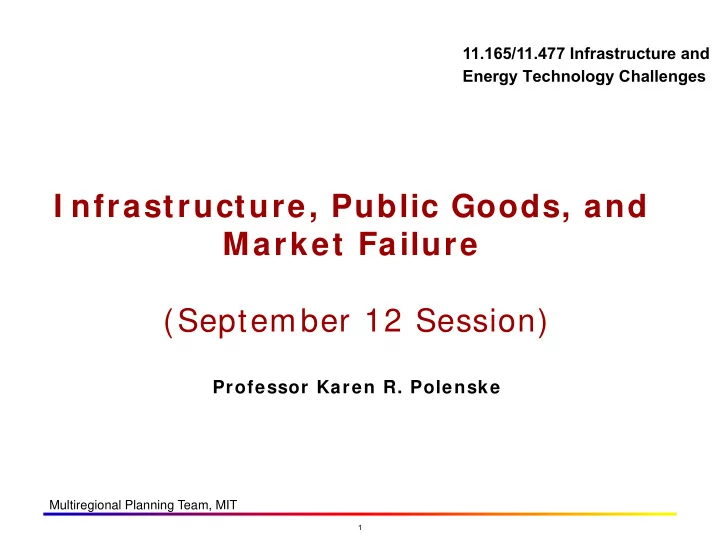

11.165/11.477 Infrastructure and Energy Technology Challenges I nfrastructure, Public Goods, and Market Failure (September 12 Session) Professor Karen R. Polenske Multiregional Planning Team, MIT 1
INFRASTRUCTURE HISTORY • When was the U.S. interstate highway system constructed? • Why was it constructed? • What about waterways (e.g., the Erie Canal, airports, pipelines? Multiregional Planning Team, MIT 2
I NFRASTRUCTURE OVERVI EW • Baseline infrastructure needs: $87 billion/year (54 billion public; utsronlkifedcbaWVUTSRPONMLKIGFECA $33 billion private) and generate 1.6 million new jobs • High end estimate: $148 billion/year (93 billion public; 55 billion private) and generate 2.6 million new jobs Multiregional Planning Team, MIT 3
I NFRASTRUCTURE OVERVI EW •What arguments support the statement that the rate of growth and infrastructure investment are related? •What is a “ productivity dividend ”? •Why would infrastructure investment create about 18,000 new jobs for every $1 billion spent (direct, indirect, and induced spending), while a tax cut would augment household spending and create only 14,000 new jobs? Multiregional Planning Team, MIT 4
I NFRASTRUCTURE OVERVI EW • Why would most of the jobs be created in construction ? • If 40% of the new jobs are created in construction and 10% in manufacturing, where are the other 50% of new jobs created? • What role do imports play? • Why does public investment improve private sector productivity ? (continued on the next slide…) Multiregional Planning Team, MIT 5
I NFRASTRUCTURE OVERVI EW • What type of public investments produce direct environmental benefits ? How does this occur? • 1950-1979 GDP and infrastructure investment grew at ~4.1 and 4.0 %/year, respectively; 1980- 2007, they grew at 2.9 and 2.3%/year, respectively GDP growth rate Infrastructure Investment growth rate 1950-1979 4.1% 4.0% 1980-2007 2.9% 2.3% Multiregional Planning Team, MIT 6
I NFRASTRUCTURE OVERVI EW • Of nondefense assets in 2007, roads represent about 32% and education almost 20%, with state and local share of nonmilitary assets being over 92%. • In 2007, 62% of all federal assets were military . utsronlkifedcbaWVUTSRPONMLKIGFECA • What happened to the regional shares of assets. Why? • Why did Washington DC and Alaska have the highest per capita shares of public investment in 2006? In what type of infrastructure did each of these regions invest? Multiregional Planning Team, MIT 7
REVI EW OF ARTI CLES • What is the “ Washington Consensus ”? Who utsronlkifedcbaWVUTSRPONMLKIGFECA formulated it? • What do the two characteristics of a public good mean? - Nonexclusive -Joint consumption • Should such goods be produced in the public sector ? Why or why not? Why do “ free riders ” exist? • What explains the production of national defense ? Is government-income maximization a motive for national defense? Why or why not? How would Holcombe explain our participation in the Iraq and Afghanistan wars? (Continued on the next slide…) Multiregional Planning Team, MIT 8
utsronlkifedcbaWVUTSRPONMLKIGFECA REVI EW OF ARTI CLES • What role does public education play in terms of public expenditures? • Give some examples of market failure . How can the public sector correct a “market failure”? • Does the market or the public sector do best in obtaining “ revealed preference ”? • Give examples to show that governments need not be democratic to be considered legitimate. Multiregional Planning Team, MIT 9
REVI EW OF ARTI CLES • Give some example of public failures ? Can the market overcome these? • Provide the views of Krueger on 1. Market failure versus government failure 2. Role of corruption 3. Licensing 4. Input subsidies 5. Government intervention and falling/rising living standards (continued on the next slide…) Multiregional Planning Team, MIT 10
utsronlkifedcbaWVUTSRPONMLKIGFECA REVI EW OF ARTI CLES Krueger , • For 1. What is the government? 2. What is the comparative advantage of government? 3. What are the ways in which government intervention works? 4. What guidance does she provide for policy makers? Multiregional Planning Team, MIT 11
REVI EW OF ARTI CLES Frishmann Economic Theory of Infrastructure and Commons Management: • Summarize what Frishmann thinks are the primary reasons that the Internet infrastructure is “socially valuable .” • Indicate the “strong economic arguments” that he provides for managing resources in an openly accessible manner • Give and critique his three key insights (continued on the next slide…) Multiregional Planning Team, MIT 12
13 REVI EW OF ARTI CLES • What is the “ comedy of the commons ”? • Explain the differences between traditional and nontraditional infrastructure. • Distinguish “ open access ” and “ commons ” and explain why Frishmann uses them interchangeably. • Explain the difference between an “apple” and an “idea.” Which one has infinite capacity ? • Explain how one can achieve Pareto optimality in regard to infrastructure. • Explain cases in which the demand curve will slope upward. Multiregional Planning Team, MIT
MIT OpenCourseWare http://ocw.mit.edu 11.165 / 11.477 Infrastructure and Energy Technology Challenges Fall 2011 For information about citing these materials or our Terms of Use, visit: http://ocw.mit.edu/terms.
Recommend
More recommend